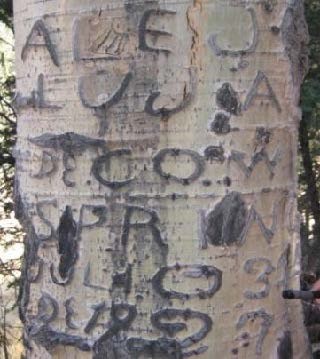Last updated: December 5, 2024
Article
Aspen Dendroglyphs as Historic Records

NPS
Encompassing more than 11,000 years of human history and influence, Valles Caldera National Preserve contains many clues of previous inhabitants and visitors on the landscape. Archeologists use these clues to piece together a record of who was here, at what time, and for what purpose. We know a lot about the individuals who owned this property in the century before it became a national preserve, but our knowledge of the everyday people who visited or worked here is limited. Dendroglyphs—or carvings left in the trunks of trees—can help us understand these individuals a little better.
Dendroglyphs can be found in aspen groves across the upper elevations of the Jemez Mountains and throughout the Rocky Mountains. Archeologists have been documenting these since the 1970s to preserve the histories of people who have otherwise been underrepresented or even excluded from the historical record of the landscape. So far, more than 2,900 dendroglyphs have been recorded by archeologists and volunteers at Valles Caldera National Preserve. Approximately 35% of the park has been surveyed.
By cross-referencing regional census records or with records kept by the Bond family ranching operations, we know that many of the names carved in the aspens at Valles Caldera came from Hispanic sheepherders. Sheepherding was active on the Baca Ranch from the 1870s until the mid-1950s. Most of the carved dates that we see on trees today are between 1920 and 1950, though the earliest observed date is 1890. The surnames of Martinez, Lujan, Trujillo, and Sanchez make up about one-third of all glyphs containing family names at Valles Caldera.


NPS
Dendroglyphs are quite fragile and can be destroyed by forest fires, elk browsing on the aspen bark, disease, and simply the death of older trees. Since there is no way to protect the glyph itself, recording the glyph preserves the information it holds. In 2008, a volunteer program was created to aid archaeologists in recording aspen dendroglyphs at Valles Caldera. To better understand the growing database of carvings recorded at the park, in 2011-2012, a graduate student at the University of New Mexico, Jonathan Knighton-Wisor, created predictive models based on the locations of aspen trees, age structures of the forests, topography, and behavior of sheepherders. These models predicted the likelihood of historic dendroglyphs across the landscape. By using these models, the volunteer crew can be directed to locations where there likely are high densities of historic dendroglyphs.
Dendroglyphs are an important cultural resource at Valles Caldera National Preserve. They are visual reminders of how people used the land in the past and linkages with the surrounding communities. By documenting dendroglyphs as a unique historic record, we can become better acquainted with the history of Valles Caldera.
